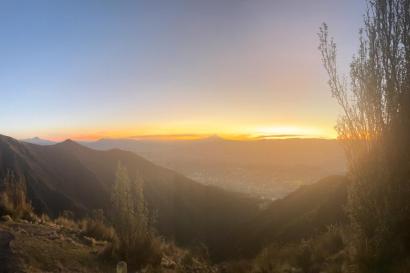Before coming to Quito, my only experience with public transportation was the D.C. metro. Depending on how familiar you are with the D.C. metro, you would understand when I say that I usually walk to most places and take the metro or bus when it is absolutely necessary. Here in Quito, I quickly realized that the transportation system is essential which is why it is used by a vast majority of citizens and as tourists you’ll become quickly accustomed to the hustle and bustle of daily public transportation. Getting around Quito is an adventure with something new and interesting to be found every day. Here is a general breakdown of the various types of transportation available in Quito.
Bus
This will be your main mode of transportation while in Quito. There are different types of buses here in Quito that go through different routes which may seem confusing at first but the great thing is that most of the buses are color-coded or have labels displaying the stops. Depending on where you live during your time in Quito you may frequently take the green buses, Ecovia, or trolebus. The buses are usually full while there is traffic which makes it prime time for theft and standing with lack of personal space to move or breathe. The great thing about the busing system is that it only costs $0.25. However the further you live from Quito, the price may vary. For example, I live in Tumabco outside of Quito, so it costs me $0.35 to get to RioCoca (the main station in Quito). In spite of the accessibility to the buses, the amount of people trying to get on or off at the same time may require you to be a little tough. Even when people yell “permiso” you have to push your way through in order to move.
Taxis
The official taxis here are yellow cars with either red, green, or black strips and an orange license plate. This means the vehicles and drivers are registered with the local government, have an orange license plate and are relatively safe. All taxis are yellow and there is always an abundant in the streets. If you take a taxi I would recommend taking one during the day and asking the driver to use the meter so that you are not overcharged for being a foreigner. REMEMBER to have change with you because if you pay with a 10 or 20 dollar bill, you might not receive back any change.
Uber
This is a fan favorite. For a more secure mode of transportation, I would recommend taking an uber. It is very, very, very cheap in comparison to the U.S. and the drivers are patient. Quite different than the US, the Uber drivers usually send a message upon arrival or wait for a few minutes if you happen to be in a different location. A cultural difference to note is that you have to sit in the front by the driver and you are usually asked if you would like to give the driver directions or follow the GPS. I never knew how much I would appreciate taking an Uber on days when I am running late to school or just going out at night.
The transportation system in Quito is different but it does not take long to get used too. Additionally, safety is important, so you can read my safety tips in my previous blog.

Tabitha Ato
I would describe myself as a fun but reserved person. I am curious and love learning and sharing about my experiences. I enjoy planning and organizing events but great music always gets me on my feet.








